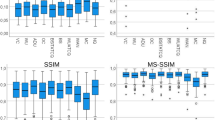Abstract
The structural similarity index (SSIM) has been shown to be a superior objective image quality metric. A web-based pilot experiment was conducted with the goal of quantifying, through the use of a sample of human participants, a trend in SSIM values showing when the human visual system can begin to perceive distortions applied to reference images. The just noticeable difference paradigm was used to determine the point at which at least 50% of participants were unable to discern between compressed and uncompressed grayscale images. For four images, this point was at an SSIM value of 96, while for two images it was at 92, for an average of 95. These results suggest that, despite the wide differences in the type of image used, the point at which a human observer cannot determine that compression has been used hovers around an SSIM value of 95.
Chapter PDF
Similar content being viewed by others
Keywords
References
Rainie, L., Brenner, J., Purcell, K.: Photos and videos as social currency online (2012), http://pewinternet.org/Reports/2012/Online-Pictures.aspx
Alexa Top Sites, http://www.alexa.com/topsites
Imgur Site Stats, http://imgur.com/stats/month
Imgur FAQ, http://imgur.com/faq#quality
Shen, M.Y., Kuo, C.C.J.: Review of Postprocessing Techniques for Compression Artifact Removal. J. Vis. Commun. Image Represent. 9, 2–14 (1998)
Skodras, A., Christopoulos, C., Ebrahimi, T.: The JPEG 2000 Still Image Compression Standard. IEEE Signal Process. Mag. 18, 36–58 (2001)
Richardson, G.: Jpeg Compression (2003), http://photo.net/learn/jpeg/
Eckert, M.P., Bradley, A.P.: Perceptual Quality Metrics Applied to Still Image Compression. Signal Process. 70, 177–200 (1998)
Wang, Z., Bovik, A.C., Sheikh, H.R., Simoncelli, E.P.: Image Quality Assessment: From Error Visibility to Structural Similarity. IEEE Trans. Image Process. 13, 600–612 (2004)
University of Southern California’s SIPI Image Database, http://sipi.usc.edu
Wikimedia Commons, https://commons.wikimedia.org
CC BY-SA 2.5 Generic License, https://creativecommons.org/licenses/by-sa/2.5/
ImageMagick, http://www.imagemagick.org
GNU Octave, https://www.gnu.org/software/octave/
Wang, Z., Bovik, A.C., Lu, L.: Why is Image Quality Assessment So Difficult? In: IEEE International Conference on Acoustics, Speech, and Signal Processing, pp. IV-3313–IV-3316. IEEE Press, New York (2002)
Kanwisher, N., McDermott, J., Chun, M.M.: The Fusiform Face Area: A Module in Human Extrastriate Cortex Specialized for Face Perception. J. Neurosci. 17, 4302–4311 (1997)
Chan, S.: That popup survey tool for Fresh & New feedback (2011), http://www.freshandnew.org/2011/01/that-popup-survey-tool-for-fresh-new-feedback/
Author information
Authors and Affiliations
Editor information
Editors and Affiliations
Rights and permissions
Copyright information
© 2013 Springer-Verlag Berlin Heidelberg
About this paper
Cite this paper
Flynn, J.R., Ward, S., Abich, J., Poole, D. (2013). Image Quality Assessment Using the SSIM and the Just Noticeable Difference Paradigm. In: Harris, D. (eds) Engineering Psychology and Cognitive Ergonomics. Understanding Human Cognition. EPCE 2013. Lecture Notes in Computer Science(), vol 8019. Springer, Berlin, Heidelberg. https://doi.org/10.1007/978-3-642-39360-0_3
Download citation
DOI: https://doi.org/10.1007/978-3-642-39360-0_3
Publisher Name: Springer, Berlin, Heidelberg
Print ISBN: 978-3-642-39359-4
Online ISBN: 978-3-642-39360-0
eBook Packages: Computer ScienceComputer Science (R0)




